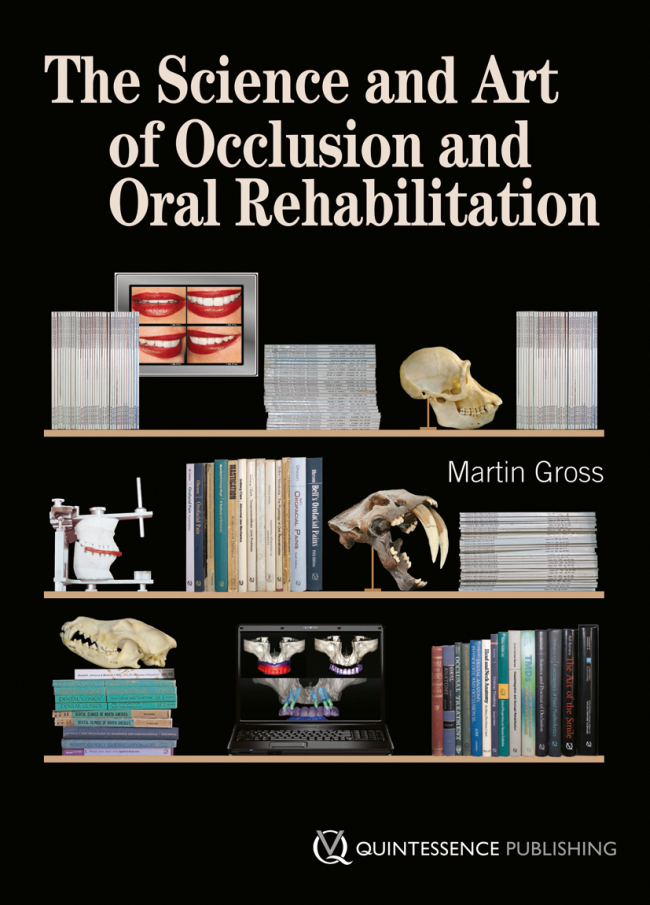Quintessence International, 8/2008
Online OnlyPubMed-ID: 19107247Seiten: 630, Sprache: EnglischNissan, Joseph / Barnea, Eitan / Carmon, Daniela / Gross, Martin / Assif, DavidObjective: To examine the influence of a reduced post length sealed with a titanium-reinforced composite luting agent on the fracture resistance of crowned endodontically treated teeth with a 2-mm ferrule on healthy tooth structure.
Method and Materials: The study consisted of 60 intact single-rooted premolars with similar root diameters and lengths. Teeth were endodontically treated and randomly divided into 6 experimental groups (n = 10) with various post lengths (5, 8, and 10 mm) and types (ParaPost and Dentatus) of equal diameter. Posts were luted with a titanium-reinforced composite resin luting agent. Titanium-reinforced composite resin cores were constructed, and cast crowns with a 2-mm ferrule on healthy tooth structure were cemented. Specimens were mounted in a jig that allowed loading of the buccal cusp in the axio-occlusal line at a 30-degree angle to the long tooth axis. A continuous compressive force at a crosshead speed of 2 mm/min was applied by an Instron testing machine. Forces at fracture (in newtons) and mode of failure were recorded. One-way analysis of variance (ANOVA) and the Scheffé test were used to statistically compare the differences among groups at a significance of 5%.
Results: ANOVA showed no statistically significant differences among the mean failure forces for the tested groups in their resistance to fracture under load. The Scheffé contrast test showed no statistically significant differences among all combinations of the 6 tested groups (F [5.59] = 0.032; P > .05).
Conclusion: Within the limitations of this study, post length did not influence the fracture resistance of crowned endodontically treated teeth with a 2-mm ferrule on healthy tooth structure. For tooth resistance, prosthesis design is more important than post characteristics.
Schlagwörter: post length, resistance to fracture
The International Journal of Prosthodontics, 4/2002
Seiten: 353-357, Sprache: EnglischGross, Martin D. / Nissan, Joseph / Ormianer, Zeev / Dvori, Shlomo / Shifman, AriePurpose: This study evaluated the effect of increasing occlusal vertical dimension (OVD) on the face height in completely dentate young adults.
Materials and Methods: Faces of 22 subjects were photographed in a standardized manner in an anterior view. Sequential photographs were taken at intercuspation and clinical rest position, with four completearch maxillary occlusal overlays increasing OVD in interincisal increments of 2, 4, 6, and 8 mm. Objective measurements were made from the photographs using facial reference markers. Ten observers made subjective evaluations of the resulting changes in face height using the sequential photographs randomly presented.
Results: Measurements of the facial markers showed that on increasing OVD, a corresponding change in lower face height was 50% of the interincisal increase in intercuspation and 40% for clinical rest position. ANOVA for repeated measures showed a statistically significant effect of the intraoral increase in OVD on lower face height. However, subjective results showed that observers were not capable of detecting changes in face height caused by an intraoral increase in OVD (2 to 6 mm intrinsically). ANOVA for the difference between dentists and nondentists showed a minimal, but significant, difference between the two groups, with dentists erring slightly less.
Conclusion: Attempts to alter face height by changing OVD within the range of 2 to 6 mm for esthetic reasons may not be visually distinguishable.
The International Journal of Oral & Maxillofacial Implants, 6/2000
Seiten: 837-842, Sprache: EnglischOrmianer, Zeev / Laufer, Ben-Zion / Nissan, Joseph / Gross, MartinExcessive heat generation at the implant-bone interface may cause bone damage and compromise osseointegration. Autopolymerizing acrylic resins are commonly used intraorally to join impression copings and suprastructure components for soldering. The effect of heat generation at the implant surface related to the exothermic setting reaction of autopolymerizing acrylic resins applied to an attached abutment was examined in vitro. Two brands of autopolymerizing acrylic resin, Duralay and GC Pattern Resin, were compared. Acrylic resin was applied to a titanium alloy abutment connected to a titanium alloy cylindric implant in varying controlled volumes, with both bulk application and brush paint-on techniques. The implant was embedded in an acrylic resin mandible in a 37°C water bath. Temperature changes were recorded via embedded thermocouples at the cervical and apical of the implant surface. Analysis of variance for repeated measures was used to compare treatment groups. A mean maximum increase in temperature of 4 to 5°C was seen at the implant cervical for both materials, with a maximum temperature increase of 6°C. No difference between Duralay and GC Pattern Resin was seen, except for bulk application to medium-sized copper bands at the implant cervical (P .05). No difference between the bulk and brush techniques was seen for all options, except for GC, where bulk application to medium-sized copper bands produced higher temperatures than the brush technique (P .05). Spray coolant reduced temperatures for bulk application of both Duralay and GC (P .05).
Schlagwörter: autopolymerizing resins, dental implants, heat generation, impression, irrigation
The International Journal of Prosthodontics, 5/1999
Seiten: 419-425, Sprache: EnglischGross, Martin D. / Ormianer, Zeev / Moshe, Kobi / Gazit, EstherPurpose: The purpose of this study was to test the hypothesis of a minimum electromyographic (EMG) rest position based on masseter surface EMG recordings of incremental opening and closing of the mandible with simultaneous audio EMG biofeedback. Materials and Methods: Nineteen alert subjects in an upright seated position opened and closed the mandible in 1-mm increments 20 mm interincisally. An electronic recording device allowed each subject to maintain the vertical dimension of each increment while simultaneously reducing right masseteric muscle activity to the minimum possible level using audio EMG biofeedback. Integrated EMG masseteric activity was recorded at each static opening and closing increment. Results: A mean plateau of integrated EMG output for all subjects with no minimum EMG point or circumscribed minimum EMG range for any of the nineteen subjects was shown. Analysis of variance for repeated measures showed no difference in opening and closing EMG levels (P = 0.27) and no interaction between opening, closing, and change in vertical dimension (P 0.0001). Conclusion: These results, with those of other studies, raise questions regarding the validity of the concept of a unique physiologic rest position of the mandible with the masseter or associated muscles at minimum muscle activity. The idea of overlapping postural ranges appears to be more appropriate.
The International Journal of Oral & Maxillofacial Implants, 1/1999
Seiten: 55-60, Sprache: EnglischMazor, Ziv / Peleg, Michael / Gross, MartinA technique for single-tooth sinus lift and simultaneous implant placement in the posterior maxilla is presented. Ten hydroxyapatite-coated cylindric implants, 13 to 15 mm in length, were placed together with a composite bone graft of demineralized freeze-dried bone allograft and autogenous bone in 10 adults. Surgical technique and anatomic considerations are discussed. Follow-up of 3 years showed successful function and no cervical bone loss in all patients.
Schlagwörter: root-form implants, single tooth, sinus augmentation
The International Journal of Oral & Maxillofacial Implants, 1/1999
Seiten: 94-100, Sprache: EnglischGross, Martin / Abramovich, Itzhak / Weiss, Ervin I.Microleakage can occur at the abutment-implant (A-I) interface in osseointegrated implants and may cause malodor and inflammation of peri-implant tissues. The degree of microleakage at the A-I interface of 5 implant systems was comparatively assessed at varying closing torques. Using colored tracing probes driven by a 2-atm pressure system, the interface microleakage of Brånemark, Sulzer Calcitek, 3i, ITI, and Steri-Oss implants was determined spectrophotometrically. Microleakage through the A-I interface occurred in all systems, with variability between systems, samples, and closing torques. As closing torque increased from 10 Ncm to 20 Ncm to manufacturers' recommended closing torques, microleakage decreased significantly (P .005) for all systems. Analysis of variance showed significant interaction between closing torques and the time course of microleakage, and between systems and the time course of microleakage (P .001). The results indicate that fluids and small molecules are capable of passing through the interface of all the A-I assemblies studied. Presumably in an in situ situation, fluids containing bacterial byproducts and nutrients required for bacterial growth may pass through the interface gap, contributing in part to clinically observed malodor and peri-implantitis.
Schlagwörter: closing torque, implant, microleakage, preload, screw loosening
The International Journal of Oral & Maxillofacial Implants, 2/1995
Seiten: 207-212, Sprache: EnglischGross, Martin / Laufer, Ben-Zion / Ormianar, ZeevExcessive heat generation at the implant-bone interface may cause irreversible bone damage and loss of osseointegration. The effect of heat generation in vitro at the implant surface caused by abutment reduction with medium- and extra-fine-grain diamond and tungsten burs in a high-speed dental turbine was examined. Titanium-alloy abutments connected to a titanium-alloy cylindrical implant embedded in an acrylic-resin mandible in a 37°C water bath were reduced horizontally and vertically. Temperature changes were recorded via embedded thermocouples at the cervix and apex of the implant surface. Analysis of variance for repeated measures was used to compare seven treatment groups. Thirty seconds of continuous cutting with standard turbine coolant caused a mean temperature increase of 1°C with a maximum of 2°C. Similar tungsten cutting caused a mean increase of 2°C with a maximum of 4.7°C, significantly higher than diamond reduction. Additional air-water spray for continuous tungsten cutting had no significant effect, while intermittent cutting for 15-second increments reduced the temperature increase by 75%. Thus, abutment reduction with medium-grit diamonds using intermittent pressure and normal turbine coolant is unlikely to cause an interface-temperature increase sufficient to cause irreversible bone damage and compromise osseointegration.
Schlagwörter: cutting instrument, heat generation, implant abutment preparation, irrigation





